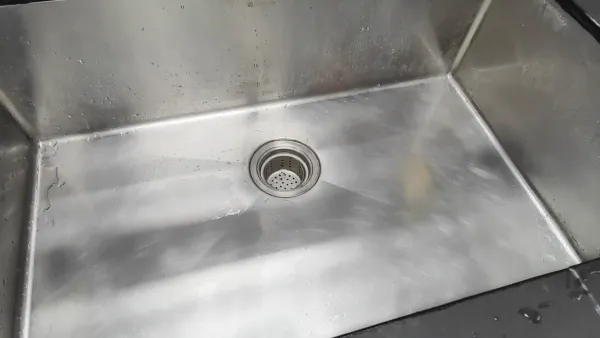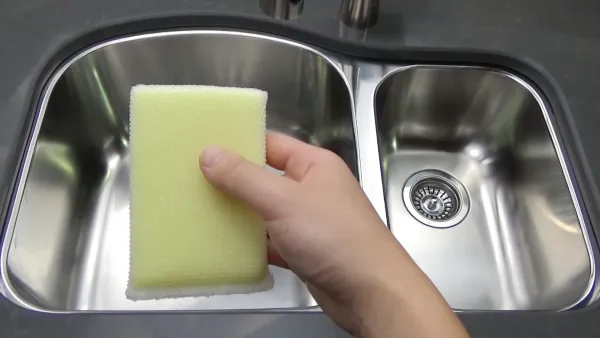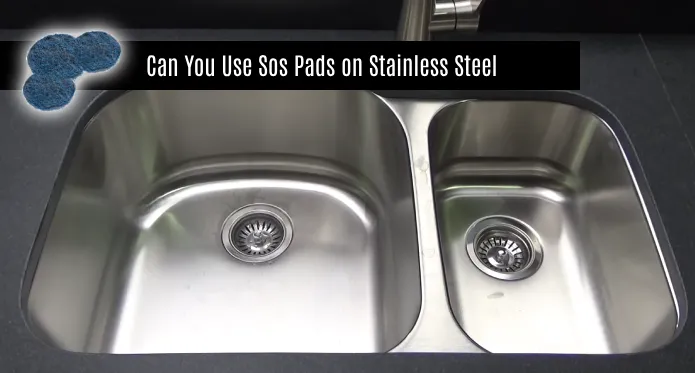Last Updated on November 14, 2023
SOS pads are a common household item known for their formidable cleaning power. In the case of your stainless steel kitchen sink, you might ask, “Can I use SOS pads on stainless steel?”
Using SOS pads on a stainless steel kitchen sink is generally not recommended due to the possibility of scratching the surface. Stainless steel sinks are prone to scratches, and SOS pads, although made of fine steel wool, can still leave marks over time if used regularly.
But, in rare cases, you can use SOS pads to remove tough stains or dried-on substances. You should exercise caution when using SOS pads on your stainless steel kitchen sink.
We will discuss why using SOS pads on your stainless steel kitchen sink is not recommended and how to use an SOS pad effectively for maximum results without damaging the sink.
Why Is It Not Recommended to Use SOS Pads on Stainless Steel Kitchen Sink?
Using SOS pads on your stainless steel kitchen sink isn’t recommended for several reasons.
- Scratching
- Surface damage
- Reducing shine
- Staining
- Difficult to restore
1. Scratching

It is not recommended to use SOS pads on your stainless steel kitchen sink because they are abrasive and can cause visible scratches.
These scratches not only affect the appearance of the sink but can also create small crevices where dirt and bacteria can accumulate, making the sink harder to clean in the long run.
Scratches on the surface of your sink can also make it more difficult to maintain its overall aesthetic appeal. Remember, a scratched stainless steel sink looks unattractive and could lead to more serious problems.
2. Surface Damage
SOS pads can damage the protective chromium oxide layer that gives stainless steel sinks its corrosion-resistant properties.
Chromium oxide forms a barrier that helps to prevent rust and corrosion from developing on the surface. When this protective layer is damaged, the sink becomes more susceptible to rust and corrosion over time.
The damage caused by abrasive pads can also make it difficult to maintain the cleanliness of the sink. Excessive use of abrasive pads on your stainless steel sink will inevitably result in reduced lifespan and aesthetic value.
3. Reducing Shine
Using abrasive pads such as SOS can dull the shine of your stainless steel sink, leaving it looking less attractive and polished. The polishing of the surface creates the vibrant, reflective surface of stainless steel sinks.
Scratches on the surface of your sink will undoubtedly affect its overall shine and polish.
4. Staining
SOS pads may contain chemicals or materials that can react with the stainless steel and stain or discolor it.
Certain types of stainless steel are more susceptible to different types of discolorations. Abrasive pads can also leave behind small microscopic fragments that can contribute to the development of discolorations.
Discolorations and stains are not only aesthetically unappealing but can also make cleaning the sink more difficult.
5. Difficult to Restore
Once the scratches or damage have been done, restoring the original appearance of your stainless steel sink can be challenging.
Repairing scratches and restoring the finish may require professional help. In some cases, the damage may be permanent, requiring more costly repairs or even a replacement.
How Can You Use an SOS Pad on a Stainless Steel Sink Without Spoiling It?

To use an SOS pad on a stainless steel kitchen sink without spoiling it, follow these guidelines:
1. Use Light Pressure
Don’t apply too much pressure while using the SOS pad on your stainless steel sink to prevent damage.
When cleaning your stainless steel sink, it’s important to use gentle scrubbing motions to avoid scratching the surface.
In spite of stainless steel’s durability, it is prone to scratches when improperly maintained. Using light pressure, you can effectively remove stains and grime without causing any harm.
Additionally, it’s recommended to use a mild cleaning solution or dish soap along with the SOS pad for optimal results. Remember to rinse the sink thoroughly after cleaning to remove any residue.
2. Rinse Thoroughly
When using an SOS pad on your stainless steel sink, rinse thoroughly with warm water to remove any steel particles or residue.
The steel particles and residue left behind by the SOS pad can react with moisture in the air, causing rust to form.
By rinsing with warm water, you ensure that all remnants of the SOS pad are removed, leaving your sink clean and free from potential rust spots.
Take the time to thoroughly rinse your sink after using an SOS pad, and you’ll keep it looking beautiful for a long time.
3. Use Sparingly
You should only use an SOS pad sparingly, as excessive use can potentially spoil the surface of your stainless steel sink.
While SOS pads are highly effective in removing tough stains and grime, their abrasive nature can cause scratches and damage to the stainless steel.
It’s important to reserve SOS pads when other cleaning methods prove ineffective.
What are the alternatives to SOS pads for cleaning your stainless steel kitchen sink?
Several alternatives to SOS pads can be used to clean your stainless steel sink. One effective option is to use a non-abrasive scrubbing sponge, which can help remove stains and grime without scratching the surface.
Additionally, stainless steel-specific cleaners and polishes can provide a gentle yet effective cleaning solution.
Another DIY alternative is a mixture of baking soda and water, which can be used as a mild abrasive paste to clean and shine the sink. Just rinse thoroughly and dry the sink after cleaning to prevent water spots and maintain its lustrous finish.
Be Mindful of Using SOS Pads On Your Stainless Steel Sink for Optimal Care and Maintenance
It isn’t recommended to use SOS pads on a stainless steel kitchen sink as they can cause scratches and damage to the surface. However, if you still want to use an SOS pad, wet it and use light pressure to avoid any harm.
Alternatively, you can try other cleaning methods, such as using a soft sponge or cloth with a gentle cleaner specifically designed for stainless steel. Taking proper care of your stainless steel sink will help maintain its shine and durability for a long time.

